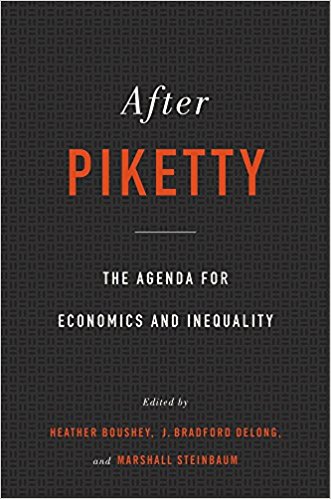Book Review | After Piketty: The Agenda for Economics and Inequality
In After Piketty: The Agenda for Economics and Inequality, editors Heather Boushey, J Bradford DeLong and Marshall Steinbaum bring together contributors to reflect on the influence of Thomas Piketty’s Capital in the Twenty-First Century and to draw attention to topics less explored in Piketty’s analysis. While this is a work of serious scholarship that is suited primarily to an academic audience, these reflections on inequality as an economic as well as moral, social and political issue are of significance for all, finds Asad Abbasi.

Thomas Piketty signs a copy of his book, Capital in the 21st Century, in Sao Paulo. September 2017. Photo: Fronteras do Pensamento/ Greg Salibian via a CC-BY-SA 2.0 licence
After Piketty: The Agenda for Economics and Inequality. Heather Boushey, J Bradford DeLong and Marshall Steinbaum (eds). Harvard University Press. 2017.
Life expectancy for people living around Canary Wharf is 89 years. For people at Canada Water, the next stop on the Jubilee line, life expectancy is 78 years. The life expectancy gap of eleven years between these two stations is equal to that between Switzerland and Bangladesh or between British women born in 2011 and British women born in the 1950s.
What explains such a dramatic change in life expectancy within a two-minute tube journey? One probable answer is that London is an unequal city. The richest ten per cent in London own 62.8 per cent of the city’s total wealth. This disparity pervades other forms of inequality such as education, political voice and even the ‘basic unit of inequality’, the life expectancy rate. But how can we account for this unequal distribution?
In 2013, Thomas Piketty’s Capital in the Twenty-First Century provided a sophisticated explanation for inequality in the western world. Unequal wealth, Piketty posited, has less to do with productivity or efficiency than with ‘the process by which wealth is accumulated and distributed’ which ‘contains powerful forces pushing towards divergence, or at any rate towards an extremely high level of inequality’ (2013, 27). Analysing this, Piketty found that historically the return on capital (r) consistently floated above the growth rate (g): r > g. In other words, wealth grows faster than economic output. This implies that the tiny fraction of people with capital will continually receive a larger share of the total wealth of the economy resulting in unequal wealth distribution, such as the one we see in London. Only a shock that increases growth, such as education or technology, or one that decreases capital, such as wars, will lessen wealth inequality.
After Piketty: The Agenda for Economics and Inequality, edited by Heather Boushey, J. Bradford De Long and Marshall Steinbaum, further explores the ‘process by which wealth is accumulated’ and the ‘powerful forces’ that shape the divergence. After Piketty starts with a neat, formal summary of Piketty’s Capital, serving as a solid foundation for anyone not familiar with this work.
The thrust of After Piketty is not that Piketty got everything wrong in his analysis but that he missed a few important points, which this book highlights. After Piketty is split into five parts. The first discusses reception of Piketty’s Capital, and in the last section Piketty is given an opportunity to respond to the ideas discussed in the volume. The middle three sections, which form the core of the text, are ‘Conceptions of Capital’, ‘Dimensions of Inequality’ and ‘Political Economy of Capital and Capitalism’. The editors have done an astute job assembling chapters of such variety under these categories.
Though George Orwell is referenced in this book, After Piketty is no Animal Farm. Readers without a background in economics will find some chapters daunting, terminology-wise. Each chapter introduces a niche aspect of inequality. Yet, the book binds together at least four common themes. First is praise of Piketty’s work and its transformative influence on academia, policy and legislation. The second articulates the need for better wealth data. The third common theme is the book’s principal focus on the US. Almost all the chapters deal with inequality in the US, except a few in which Europe, Britain and the Global South are discussed. The fourth theme, and the one which I will discuss in this review, is about the ‘process’ of wealth accumulation and the ‘powerful forces’ causing wealth divergence.
What explains the divergence?
Chapters Two and Three by Robert Solow and Paul Krugman – originally published as reviews for Piketty’s Capital in New Republic (April 2014) and New York Review of Books (May 2014) respectively – lead the discussion of Piketty’s analysis. For Krugman, not wealth but the ‘compensation and income’ (67) of the top tier, at least in the US, are the source of the divergence. Solow, however, agrees with Piketty that r > g causes divergence, but suggests that this equation is ‘not rooted in any failure of economic institution’ but ‘on the ability of the economy to absorb increasing amounts of capital without substantial fall in rate of return’. The absorption of capital, Solow explains, ‘may be good for the economy […] but […] not for equity within the economy’ (55). But is it an inherent quality of economy to absorb capital without a fall in rate of return? Not really.
For Suresh Naidu (Chapter Five), the process of wealth accumulation is not ‘guaranteed, but instead must be maintained via government administration and the legal systems’ (115). Naidu dissects Piketty into ‘Domestic Piketty’, in which politics plays a passive role, and ‘Wild Piketty’, where politics, and in particular institutions, form an important framework for understanding capital. For Elisabeth Jacobs (Chapter 21), the role of the state in Piketty’s work ‘is remarkably sanitized of any question of power dynamics’ (517). Power is ‘everywhere and nowhere’ in Piketty’s history (512). Jacobs uses Albert Hirschman’s categories of voice, exit and loyalty to show the politics behind the ‘powerful forces’.
For Laura Tyson and Michael Spence (Chapter Eight), the ‘powerful force’ causing inequality is digital technology. Digital technology enables two things. First, technology enables capital to move towards cheap labour. Second, it substitutes low-cost workers with machines. For David Weil (Chapter Nine), it is the ‘outsourcing’ of jobs, which ‘allows redistribution of gains upwards’ (224). Through outsourcing, large firms create a ‘competition between service providers’, which results in lower wages for those working for them.
For David Grewal (Chapter Nineteen), ‘legal foundations’ form the powerful force which enables the ‘persistent dominance of capital over the rest of the economy’ (472). Markets are not something ‘in the abstract’ but a type of ‘socioeconomic regime’ (478). And it is the ‘higher order constitutional protection for property’ (485), which is difficult to change, that provides the persistent high rate of return throughout history for the propertied class – the elites.
The elites, Boushey notes in Chapter Fifteen, ‘are increasingly marrying each other’ (374), affecting present income and future bequests (375), thereby resembling the marriage markets of the nineteenth and twentieth centuries. However, elites of our times are unique because they are, according to Gareth Jones (Chapter Twelve), ‘Non-Doms’: mobile and living in several countries at one time. Jacobs makes a similar argument: ‘Global elites can essentially shop for the destination that will treat their resources more favourably’ (537).
Just like the elites, the capital of the twenty-first century is also different from earlier eras. The rate of return is maintained by forming ‘extra legal spaces’, such as tax havens and other offshore jurisdictions which blur legal controls and capital information (290). The City of London, Jones suggests, doesn’t pay its accountants £2 billion per year for accurate information (292).
Even if, as described by Piketty, the process of accumulation and the forces of power that render wealth inequality prove correct – that is, r > g – even then, for Branko Milanovic, high inequality is avoidable. The famous ‘Elephant curve’, which appears in Christoph Lakner’s chapter on global inequality, shows that the low-income earners in the west, the blue collar workers, gained zilch from globalisation. Think Brexit. The remedy, Milanovic proposes, is ‘wider ownership of capital’ (256).
For Daina Ramey Berry (Chapter Six), it is important to analyse the initial divergence of income between the rich and the poor. Contrary to Piketty’s ‘anodyne model of capital accumulation’, Ramay writes that the ‘colonial and antebellum 1 percent became rich by exploiting enslaved people’s labour’. For Berry, Piketty ignores ‘the fact that the slave trading and slave labour were at the foundations of western economies from the fifteenth century through nineteenth century’ (129).
In response, if not outright defence, Piketty admits that his book didn’t ‘devote sufficient attention’ to slavery. He does point out that ‘slave value reported’ in his work attempts the ‘first explicit computation’ of a slave economy (549), but also that these are ‘based upon total number of slaves recorded in census, whether they are owned by private individuals, corporation, or municipal governments, so I am not sure they are as strongly underestimated as suggested by Daina Ramey Berry’ (658, n15).
In the final chapter, Piketty explains, defends and elaborates upon Capital. Capital, Piketty notes, embodies multidimensional history, rooted as much in politics as in economics. Capital serves as an ‘introduction’ to this history (548-53). ‘Had I believed’, Piketty quips, ‘in the one dimensional neoclassical model of capital accumulation […] then my book would have been 30 pages long rather than 800 pages’.
Piketty argues that capitalism contains an inherent capacity to produce unequal societies. In order to rein this tendency, he suggests implementing a global wealth tax. More importantly, Piketty hopes that his work provokes discussion on wealth and inequality. After Piketty not only generates such debate, but also deepens it by highlighting the gaps missed by Piketty. For this reason, After Piketty ticks the box as being as much an ‘homage’ to, as a critique of, Piketty’s Capital.
After Piketty is not your typical holiday read. It is work of serious scholarship. The academic language of some chapters pinpoints its intended audience: scholars, students, policymakers and politicians. Yet, the topics discussed in the book affect all citizens. High inequality should concern everyone because it is a moral, social and political issue.
As the United Kingdom negotiates exit terms with EU officials, it seems that ‘decades of inequality’ in Britain, and the EU’s commitment towards the ‘profit making interests of a tiny elite’, resulted in Brexit. In The Age of Uncertainty, John Galbraith warned against the tumultuous effects of unequal wealth: ‘When reforms from the top became impossible, the revolution from the bottom became inevitable’.
This post represents the views of the author and not those of Democratic Audit. It first appeared at the LSE Review of Books.
Asad Abbasi has a Masters degree in Political Economy of Late Development from the LSE. Currently, he is researching conceptual frameworks of development.

 Find this book:
Find this book: 



 Democratic Audit's core funding is provided by the Joseph Rowntree Charitable Trust. Additional funding is provided by the London School of Economics.
Democratic Audit's core funding is provided by the Joseph Rowntree Charitable Trust. Additional funding is provided by the London School of Economics.